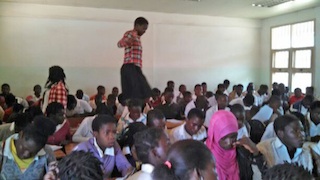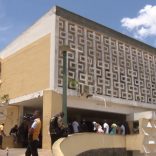Mozambique: Health Ministry confirms shortage of BCG vaccine
Classes of 173 students in Niassa; Mozambique needs 32,000 more classrooms – A Verdade

A Verdade / Scool in Niassa
Officially, there is one teacher for each class of 62 students in Mozambique, a number which the government’s Five Year Plan (PQG) proposes to reduce to 57 students per class. @Verdade however has found five schools in Niassa with classes of more than 100 students, and, in one case, 173 secondary schools students studying for grade 8.
With a deficit of more than 32,000 classrooms in the country, the PQG proposes to build 4,500 new rooms by 2019.
“Quality education in Mozambique continues to be a utopian dream,” a secondary school teaching a class of more than 100 students says. “For some time now, Mozambican political discourse has been fuelled by fallacies about the quality of education. However, the scenario is contradictory, because we still find large numbers of overcrowded classes.”
The teacher, who spoke with @Verdade on condition of anonymity, has no illusions that it is “the process of school planning which stifles the quality and efficient intervention of the teacher, who ends up being the one most sacrificed”.
“The above-normal class size make of us the least prestigious of all professions, because we cannot report to our boss satisfactorily and, as a consequence, we are forced marks according to a percentage that pleases those who plan the annual school year badly,” the veteran secondary teacher from Niassa complains.
Our source even reports that overcrowding, which occurs not only in his class but also in other schools, has caused students to faint, as well as low academic performance and school equipment lasting very little time.
By way of remedy, the teacher suggests improving school planning, reducing the number of students per class to a maximum of 45 and building more schools.

In an interview with @Verdade, Provincial Director of Education and Human Development Faustino Amimo acknowledged that there classes of more than 100 students in Niassa. “It is a fact. As you know, in secondary education, especially in the large urban centres, we have class sizes above average. This is a challenge that the sector faces and we must continue working to address it.”
Amimo ackowledged that there are five schools with classes of more than one hundred students. At the Escola Secundária Cristiano Paulo Taimo, the number of students ranges from 137 to 173 students per class; at Chiulugo Secondary School there are classes with up to 147 students, and at the Muchenga Secondary School there are 1,900 students in 18 classes.
“At primary level there are two (schools with classes of more than 100 students). They are the Chilaula Primary School, which teaches 1,929 Grade 1 to Grade 7 students in 16 classes. And we also have Chiulugo Elementary School, which teaches 2,474 1st degree (Grade 1 to Grade 5) students in 21 classes,” he said.
Amimo also acknowledged that the overcrowded classes situation “is not new. The school population has been growing in recent years. Greater demand requires that more classrooms are built”.

The Ministry of Education and Human Development told @Verdade that there was a deficit of 32,687 classrooms in Mozambique. Niassa province needs at least 1,847: 1,478 for primary education and 369 for secondary education.
“One of the strategies to reverse this situation in our provinces is to build more classrooms, to hire more teachers, this would allow gradually reduce this gap towards the demand,” explained the provincial director, pointing out that, in 2017, “the construction of 33 classrooms is under way: 32 for primary education and one for secondary education in Lago District”. Last year, only 26 classrooms were built.
But the dearth of classrooms has no end in sight. To fill the deficit, Filipe Jacinto Nyusi’s 2015-2019 Five Year Plan only foresees the construction of 4,500 new classrooms, and does not plan to build any new schools.













Leave a Reply
Be the First to Comment!
You must be logged in to post a comment.
You must be logged in to post a comment.